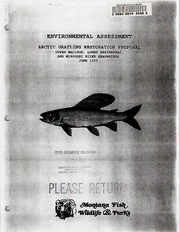
Arctic grayling restoration proposal, Upper Madison, Lower Beaverhead, and Missouri River Headwaters : environmental assessment PDF
Preview Arctic grayling restoration proposal, Upper Madison, Lower Beaverhead, and Missouri River Headwaters : environmental assessment
« V MONTANASTATELIBRARY 30864 0014 55594 .. . i;.v;- mi W& [ ‘ % ENVIRONMENTAL ASSESSMENT *'vV-:Vv‘Jl5KL%HkSt^£V«v"Jtj***' ARCTIC GRAYLING RESTORATION PROPOSAL : ;;:gk UPPER MADISON, LOWER BEAVERHEAD, AND MISSOURI RIVER HEADWATERS JUNE 1999 STATEDDCUMEHiSCu «*\VT»rW. MONTANASir HELEN15A1,5MEO.N6 • • S’*-i iweRfii^c.vv'o:/ %* «5Moqtaqa Tist^, :-v 'r, f fir DRAFT MEPA/NEPA/HB495 CHECKLIST PARTI. PROPOSEDACTION DESCRIPTION 1. TypeofProposedStateActionProposaltoreintroducefluvialArcticaravlinato threeriversitesintheupperMissouriRiverdrainageaboveTostonDam. 2. AgencyAuthorityfortheProposedActionMontanaFish,Wildlife&Parks 3. NameofProjectReestablishmentoffluvialArcticaravlina. 4. Name,AddressandPhoneNumberofProjectSponsor(ifotherthantheagency) N/A 5. IfApplicable: EstimatedConstruction/CommencementDateSeptember1999 EstimatedCompletionDateN/A CurrentStatusofProjectDesign(%complete)N/A 6. LocationAffectedbyProposedAction(county,rangeandtownship) 1. MissouriRiverfromTostonDamtoitsheadwatersatThreeForks(22miles), includingtheGallatinRiverfromitsmouthtotheconfluenceoftheEast GallatinRiver(12miles),theMadisonRiverfromitsmouthtotheGreycliff FishingAccessSite(21 miles),andtheJeffersonRiverfromitsmouthtothe confluenceofWillowCreek(18miles). 2. MadisonRiverfromtheheadofEnnisReservoirtotheoutletofEarthquake Lake(56miles). 3. BeaverheadRiverfromitsmouthtotheconfluenceofStoddenSlough(40 miles). 7. ProjectSize:Estimatethenumberofacresthatwouldbedirectlyaffectedthatare currently: (a) Developed: (e) Productive: residential acres irrigatedcropland . acres industrial acres drycropland ... . acres forestry acres (b) OpenSpace/Woodlands/ rangeland acres Recreation acres other acres (c) Wetlands/Riparian Areas acres (d) Floodplain _acres 1 8. MUaSpG/sSit7e.5p'lasne:riaetsttacohpoagnraoprhiigicnamla8p1s4h"oxwi1n1g"tohrellaorcgaetriosnecatnidonboofuntdhaerimeosstofrtehceenatrea thatwouldbeaffectedbytheproposedaction.Adifferentmapscalemaybe substitutedifmoreappropriateorifrequiredbyagencyrule. Ifavailable,asiteplan shouldalsobeattached. Seeattachedmap. 9. NarrativeSummaryoftheProposedActionorProjectincludingtheBenefitsand PurposeoftheProposedAction. Arcticgrayling(Thvmallusarcticus)wereoncewidespreadintheMissouriRiverdrainage upstreamfromGreatFalls. Duringthe20thcentury,therangeoffluvial,orriver-dwelling, graylingbecamerestrictedtotheBigHoleRiver,whichrepresentsabout4%ofitsnative range. TheBigHoleRivergraylingpopulationdeclinedinabundanceinthemid1980'sto 22permilein1989,aprecariouslylowlevel. Concernforthepopulationresultedin formationoftheInteragencyFluvialArcticGraylingWorkgroup(FGW)tocoordinate restorationoffluvialgraylingintheBigHoleRiverandthroughoutitsnativerangein Montana. TheMontanaFluvialArcticGraylingRestorationPlanwasdevelopedtorecover fluvialArcticgraylingwithagoalofatleastfivestable,viablepopulationsdistributed amongatleastthreeofthemajorriverdrainageswithinthehistoricrangeofMontana grayling. AmemorandumofagreementbetweentheU.S.FishandWildlifeServiceandMontanaFish, Wildlife&ParksrequiresfourreintroductioneffortstobeinprogressbyDecember31, 2000. ThereintroductionofgraylingtotheupperRubyRiver,aboveRubyReservoir,has beenongoingsince1997;theNorthandSouthforksoftheSunRiverareslatedtobeginin June1999. InJuly1998,theFGWsupportedthreeadditionalreintroductionsites:(1)the MissouriRiverHeadwatersnearThreeForks,(2)theupperMadisonRiver,and(3)thelower BeaverheadRiver(seeattachedmaps). Thelongriverreacheswithinthedesignatedboundariesofthethreeproposedsitesare targetedforgraylingreintroduction. However,introducedgraylingcouldstraybeyondthese boundariesandpotentiallyestablishyear-roundorseasonalpopulationselsewhere. The lengthofthereaches-40,56and73miles-shouldhelptominimizestraying. Theselong, unimpededreachesareneededtoaccommodatetheseasonalmigrationsthatarebelieved tocharacterizefluvialgraylingpopulations. Thethreeproposedreintroductionsitesgenerallycontainsuitablegraylinghabitat, specificallylongreachesoflow-gradientstream,deeppoolsandruns,adequatespawning gravelandacceptablewaterquality. However,eachhasshortcomingsthatcouldhinder success. Abriefdiscussionofeachsite'spositiveandnegativeattributesfollows. 1. MissouriRiverHeadwaters Thisreintroductionsite,whichencompasses73rivermiles,beginsatTostonDam, extendstotheMissouriRiverheadwatersatThreeForksandcontinuesupstream intothelowerreachesoftheGallatin,JeffersonandMadisonrivers. Unimpeded accessintolongreachesofpotentialgraylinghabitatcharacterizethesite. Thefour affectedreachesontheMissouri,Madison,GallatinandJeffersonriverssupportlow numbersofpotentiallycompetingnon-nativetrout,estimatedatabout225-600 adultspermileofriver;offeraccesstopotentialgraylingspawningareasinthe Gallatin,MadisonandJeffersonRiverdrainages;containdeeppoolsandside channels,habitatswellsuitedforgrayling;andsupportlowanglingpressure. Trout populations,althoughlow,aredominatedbybrowntrout,apotentiallystrong predator/competitorthatcouldinfluencereintroductionsuccess. Other 2 € 0 Aio/m^Aim/fona^icABcticjaul Jefferson River Scale1:194300 i*iiii‘iiii|n\ini'fniMfii/'iiiixmiriirri]i shortcomingsincludetheperiodicsummerdewateringoftheMissouri,Gallatinand Jeffersonriversandanaccompanyingincreaseinwatertemperatures,whichcan reachnearlethallevelsforsalmonids;thechronicallyhighsummerwater temperaturesofthelowerMadisonRiver,whicharepasseddownstreamtothe MissouriRiver;andin-channelsedimentaccumulationsthatdegradepotential graylinghabitats. 2. UpperMadisonRiver This56-mile-reachbetweenEnnisReservoirandEarthquakeLakewasinitially precludedasareintroductionsiteduetothepresenceof"lake-dwelling"graylingin EnnisReservoirandthepotentialtogeneticallycontaminatethisresidentstock. A subsequentgeneticriskassessmentconcludedthattheriskwasminimalanda reintroductioncouldproceed. WhirlingdiseasehasreducedtheMadison'soncethrivingrainbowtroutpopulation toabout1,100ageoneandolderfishpermileinthePineButtesection,whichis wellbelowthepre-whirlingdiseaseaverageofabout3,800fishpermile. Inthe Varneysection,wheretraditionalgraylinghabitatsaremoreprevalent,rainbow troutsdensitiesarecurrently350-400ageoneandolderfishpermile,reducedfrom pre-whirlingdiseasedensitiesof500-1000fishpermile. Depressedrainbow numbersintheMadisonRivercouldbenefitgraylingsurvival,therebyenhancing reintroductionsuccess. However,theMadison'sdepressedrainbowpopulationis stillpotentiallycapableofoverwhelmingtheintroducedgrayling. Infieldtrialson theBigHoleRivertoobserveinteractionsbetweengraylingandrainbowtrout, graylingwereabletodefendtheirpositionsagainstincursionsbyrainbowtroutuntil rainbownumbersfarexceededthoseofgrayling,forcinggraylingtoexpendmore energydefendingtheirpositionsthantheygainedfromfeeding. Oncerainbowtrout exceededanapproximatedensityof500-1,000permile.BigHolegraylingwere apparentlyunsuccessfulatcompetingforspace. Rainbowtroutdensitiesinthe upperreaches(PineButte)oftheMadisonRiver,althoughmoderateatbest,may exceedthecriticalthresholdderivedfromtheBigHolestudies. Avalidconcernis thattheintroducedgraylingmaynotsuccessfullycompeteattheplanteddensities likelytobeachievedintheMadisonRiver. Moreover,theMadison'sbrowntrout,a potentiallystrongpredator/competitorofgrayling,continuetoflourishat1,000- 2,500fishperrivermile. Browntroutdensitiesarehighestdownstreamfrom Varney,whichisalsothestretchhavingthebestpotentialhabitat-large,deep pools,numeroussidechannelsandareasofslowmovingwater-forgrayling. UpstreamfromVarney,fastflowing,shallowriffles-habitatslesssuitedforgrayling -predominate. Habitatlimitationscoupledwithsignificantrainbowtroutdensities andastrongbrowntroutpopulationarepotentialshortcomingsthatcouldhinder success. AnotherpotentialproblemisthereadyaccesstoEnnisReservoir. Atheory, althoughunproven,isthatgraylingwillnotremainfluvialovertimeiftheyhave unimpededaccesstoanearbylakeorreservoir. Plantedgraylingandtheiroffspring couldenterEnnisReservoir,develop"lake-dwelling"traitsandonlyreturntothe MadisonRiveranditstributariestospawn,therebyalteringthefluvialbehaviorof theintroducedgrayling. PositiveattributesoftheMadisonRiverreintroductionsiteincludetheabsenceof significantstreamdewatering;presenceoffavorableyear-roundwatertemperatures; excellentwaterquality;anabundanceofspawninggravel;goodoverallproductivity; andhealthystreambanksandriparianhabitats. 7 3. LowerBeaverheadRiver ThedesignatedreintroductionsiteontheBeaverheadRiverencompassesthe40 milesofriverbetweentheconfluenceofStoddenSlough,downstreamfromDillon, andtheriver'smouthatTwinBridges. ThedamatBarrett'sDiversionwould preventgraylingfromstrayingupstreamandenteringthepopularandhighly productivetroutfisheryoftheupperBeaverheadRiver. Interactionwiththegrayling spuopcucleaetdiso.noLfotwhenunmeibgehrbsoroifngbrBoigwnHotlreoutRi(vearboiusta3p0o0ssipbeirlimtiyleif)rienihnatbriotdutchteion reintroductionsite;fewrainbowtroutarepresent. Fishingpressureislow. Freshly erodedgravelneededforspawningisreadilyavailable. TheconstructionofClark CanyonDaminthemid-1960seliminatedtheextremedewateringthatlikely contributedtothehistoricdemiseoftheriver'sgraylingpopulation. However, periodicdewateringandaccompanyinghighwatertemperaturesarestillaproblem. Aninvertedhydrograph(annualhighflowsoccurinwinter,ratherthanspring),poor riparianhealth,andin-channelsedimentaccumulationscouldfurtherhindersuccess. Selectivestockingofthethreereintroductionsitescouldbeginasearlyasfall1999.Yearling(over- wintered)graylingdescendedfromwild,fluvialBigHolestockwillbeplanted. TheBigHoleRiver graylinghavesurvivedmanyenvironmentalchangesoverthepast100years,includingstream dewatering,elevatedwatertemperatures,barriersblockingseasonalmigrations,andnon-native troutintroductions. ProgenyfromthesurvivingBigHolestockmayofferabetterchanceto reestablishpopulationsinthemodifiedand/ordegradedaquaticreachesthatcharacterizevirtually allofMontana'srivers,includingtheproposedreintroductionsites. Stockingaminimumofabout350yearlingspermile-atotalof59,150forthe169milesof affectedwater-istheannualgoal. Assumingabouta75%annualmortalityofstockedyearlings, (basedonpreviousAlaskastudiesandoverwintersurvivalofstockedyearlinggraylingintheRuby River1998-1999),approximately90survivorsarelikelytoremainpermileafteroneyear,whichis srtoaugnhdlayrdthFeWBPighaHsolfeorRievsetri'msathiingghetshteddeennssiittyyotfhaatg'es1neaenddedoltdoerpgerrapyeltiunagteinaresceelnf-tsuysetaarisni-ngthgeraoynlliyng population. Ifsurvivalafterthefirstyear'splantisinadequate,subsequentstockingratesmaybe increased(ifexcessyearlingsareavailable)toimprovethechanceofsuccess. FWPdoesnotanticipatehavingasufficientsupplyofyearlinggraylingtomeetreintroductiongoals atallongoingandproposedsitesuntil2001. Untilthen,theproposedsiteswillbebroughtonline basedonthesupplyofavailablegrayling. Oncestockingbegins,asitewillbeplantedforfour consecutiveyearsunlessdataindicatethattheestablishmentofareproducing,self-sustaining populationisunlikely. YearlinggraylingwillbereleasedinlateJuneorearlyJulyimmediately followingspringrunoff. Monitoringtoevaluatereintroductionsuccessandtodocumentfactorsthatmayhinderorhelp futurereintroductionswillbeconductedbyFWP. Monitoringwillcontinueforatleastthreeyears followingthelast(4th)yearofplanting. ThisallowsFWPtodetermineifreproductionbythe progenyofstockedgraylingissufficienttosustainapopulation. GraylingmonitoringwillbeincorporatedintoFWP'sexistingelectrofishingstudies,whichare annuallyorperiodicallyconductedontheupperandlowerreachesoftheMadisonRiver,thelower BeaverheadRiverandthelowerJeffersonRivertoassesstroutpopulations. Formerelectrofishing studysectionsontheMissouriRivernearThreeForksandthelowerGallatinRiverwillbe reactivatedtogathertroutdataandtomonitorgrayling. Establishedstudyreachesontheupper MadisonRiverincludethe(1)PineButte,(2)Snoballand(3)Varneysections. Studyreachesfor theMissouriHeadwatersreintroductionsiteinclude(1)theGreycliffsectionofthelowerMadison River,(2)LogansectionofthelowerGallatinRiver,(3)ThreeForkssectionofthelowerJefferson Riverand(4)TridentsectionoftheMissouriRiver. ForthelowerBeaverheadRiver,studyreaches includethe(1)AndersonLane,(2)MuleShoeand(3)TwinBridgessections. Additionalsitesmay besurveyedtodefinegraylingdistributionandtoidentifyimportanthabitats. Populationworkin 8
